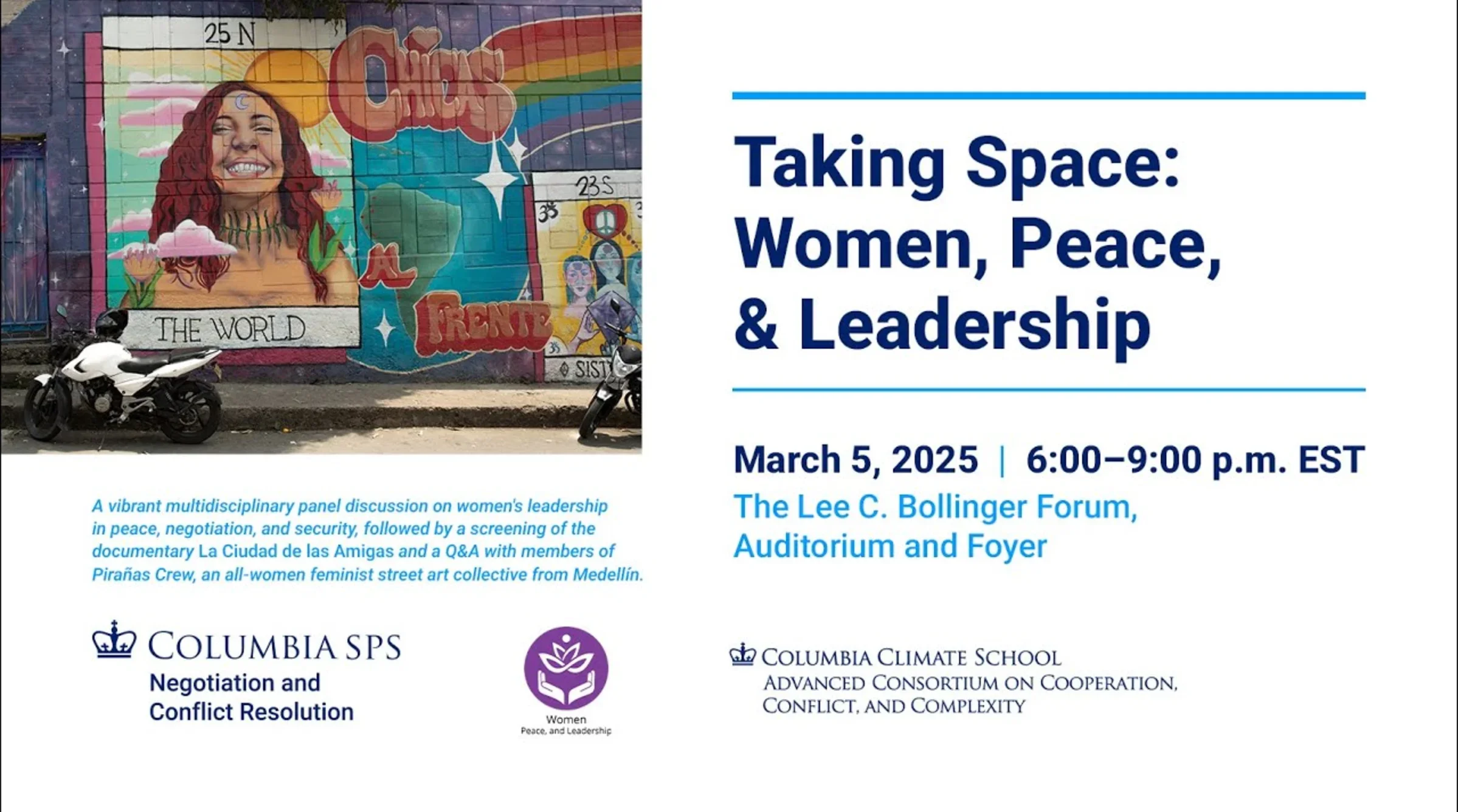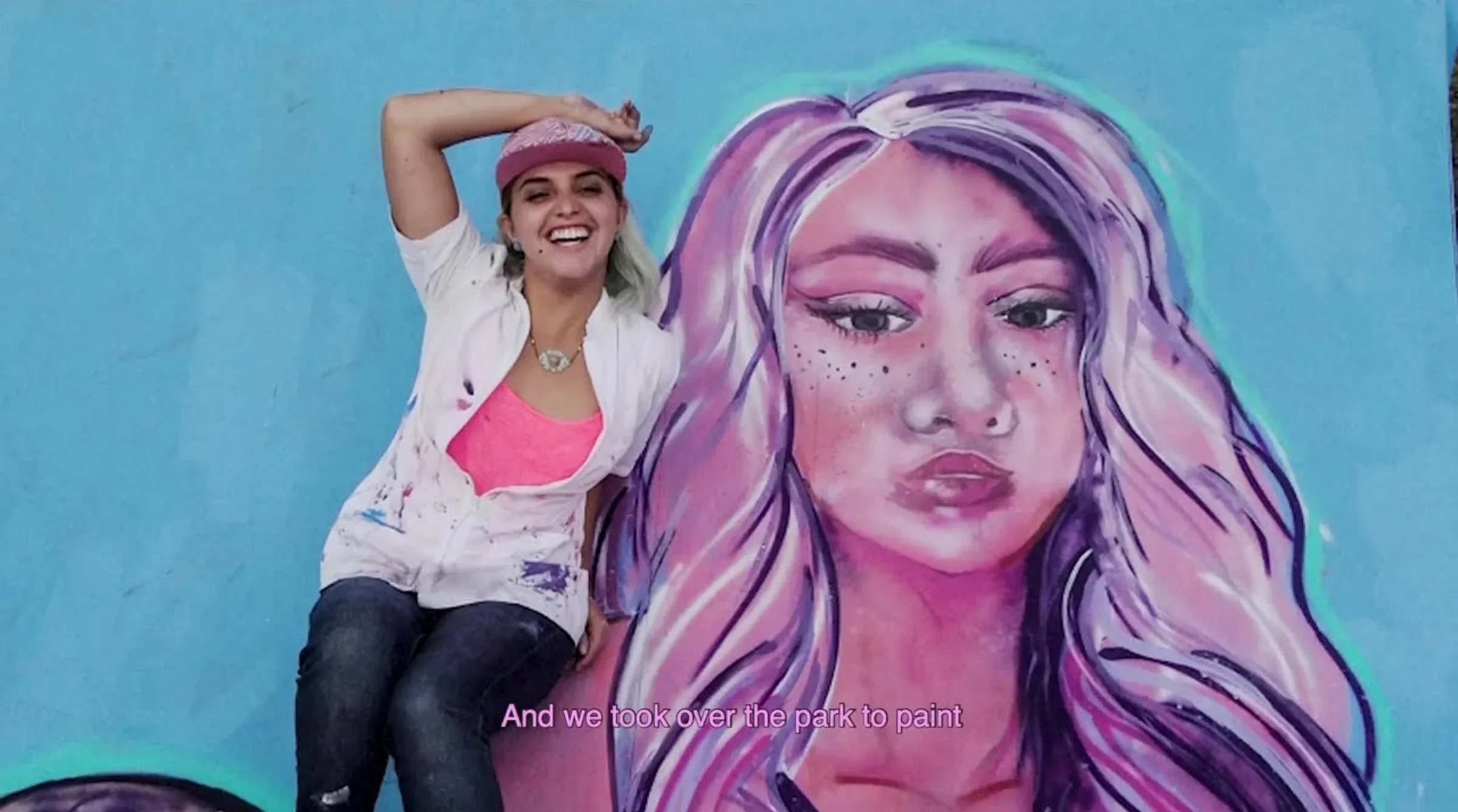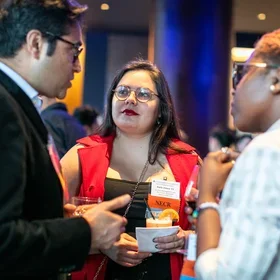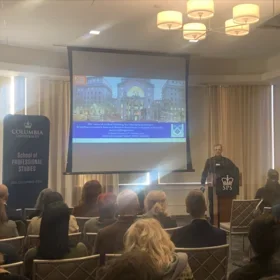Lasting peace demands the amplification of women's voices.
The Columbia University School of Professional Studies M.S. in Negotiation and Conflict Resolution program, in partnership with Columbia Climate School's Advanced Consortium on Cooperation, Conflict, and Complexity (AC4), delivered a powerful exploration of the role of women in major global peace initiatives across Africa, Eastern Europe, and Latin America this International Women's Month.
“Taking Space: Women, Peace, and Leadership,” the inaugural event of the Women, Peace, and Leadership (WPL) program, delved into the roles of women in various aspects of peace and security around the globe—from grassroots movements in post-Soviet nations to the vibrant, defiant art of Colombian street collectives. The multidisciplinary event was held at the Lee C. Bollinger Forum on Columbia’s Morningside Heights campus.
Chilean Women's Artistic Activism
Author and human rights attorney Flynn Coleman recalled the “loud energy” of a room of Chilean women making memorial tapestries that depicted scenes of disappearances and torture under former president Augusto Pinochet.
“This art wasn’t just art. It was justice, it was resistance,” she said.
But she noted that the communal effort also involved building financial and business skills, pausing to ask: “Whose story isn’t being told? Who still isn’t at the table?” Her question pointed to the need for higher-level representation in peace negotiations, and was addressed by the other members of the panel, which was moderated by Dr. Beth Fisher-Yoshida, director of the Negotiation and Conflict Resolution program.

Negotiation and Conflict Resolution Program Director Dr. Beth Fisher-Yoshida (left) and author and human rights attorney Flynn Coleman.
Amplifying Women's Voices in Peacebuilding
Julia Vassileva, a visiting scholar at Columbia Climate School's AC4, discussed the roles of women in peacebuilding in post-Soviet spaces. She noted that women have often been involved in peace efforts at the grassroots level, but upper level work is done by diplomats, who are predominantly male. Research has shown, however, that negotiations are resolved more quickly and agreements last longer when women are involved, she said.
Catherine Andela, a senior gender adviser and chief of the Gender Unit at the UN Department of Peace Operations, discussed her fieldwork in West Africa and the Middle East. She brought the two previous positions together, saying that when women move into positions of power, they need to bring the voices of women “on the ground” with them.
During a brief Q&A, Andela responded to a question about the qualities women bring to the table by noting their emotional intelligence and insights.
Negotiations are “tense environments where, if there were only men in the room, then they would be shouting at each other and very ego-driven, not finding an agreement,” Vassileva said.
Public Art as Historical Memory
Following the screening of La Ciudad de las Amigas (The City of Friends), a documentary about the Pirañas Crew of graffiti artists founded 12 years ago, the director and several members of the crew discussed the film and their work.
“The hip hop and street art world is a very masculine and male-dominated world,” said Lieke Prins, a crew member and doctoral candidate in Latin American studies. “As women, we have to continue to persist and resist these masculine structures,” she said, noting that the crew has faced backlash from lewd comments to having their murals defaced.
Those realities were made evident in the Pirañas documentary. Director Juliana Ruiz took the moment to express pride in the film and in the crew. “It’s a great start and a great way to honor the girls that are part of the crew,” she said. “We dreamed to be here, we dreamt of this day.”
The documentary shows the challenges women face, according to Anyela Vanegas Arango, a crew member and attorney specializing in gender issues. Arango’s comments were translated by the panel’s moderator, Joan Camilo Lopez, a lecturer in the M.S. in Negotiation and Conflict Resolution and program manager for the Earth Institute at Columbia University. Other women have followed the Pirañas lead and initiated their own public art projects, she said.
Arango called street art a form of “historical memory,” a way to spread censored information and pay tribute to victims of violence. “Urban art serves another purpose,” she said. “It communicates things that the people do not want to communicate, that the conventional media doesn’t communicate.”
The event made clear how, through art, activism, and diplomacy, some women are finding ways to record history while women in other parts of the world are working to become the shapers of history.
View the entire “Taking Space: Women, Peace, and Leadership” discussion in the two-part video below:
About the Program
Columbia University’s Master of Science in Negotiation and Conflict Resolution prepares students to analyze the root causes and dynamics of conflict and to transform disputes through reasoned and resourceful interventions. The program focuses on developing self-awareness, tenacity, and interpersonal competency; building common ground; opening lines of communication; ensuring representation and recognition, and building sustainable possibilities for resolution.
The fall 2025 application deadline for the M.S. in Negotiation and Conflict Resolution program is May 1. The program has on-campus and online (with residency) modality options. Learn more here.




